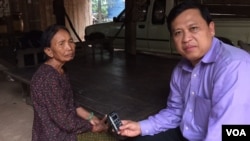Another suspect in a fourth case before the Khmer Rouge tribunal will be investigated, the UN-backed court said.
International investigating judge Michael Bohlander has put Ao An, better known as Ta An, under investigation, though the decision was not supported by his Cambodian counterpart. It is the second time that Ao An came to the court to hear the charge against him. A tribunal spokesman would not confirm whether there was a division between the two judges over the case, No. 004.
Critics of the court say they doubt cases 003 and 004 will see trial, as they have been strongly opposed by Prime Minister Hun Sen and other senior government leaders.
Ta An appeared in court for the first time in March 2015, but he will face even more charges under the current investigation, the court said Monday.
The announcement comes on the heels of a court decision to separate the case of Khmer Rouge leader Im Chaem from Case 004, which includes suspect Ta An and another leader, Ta Tith.
Prosecutors say Ta An oversaw a number of Khmer Rouge atrocities, as he rose to deputy secretary of the Central Zone under the regime’s political structure.
As such, he was second in command in the area, based in Kampong Cham province, where up to 150,000 people died under the regime, including a large number of Cham minorities.
The charges now include genocide against Muslims, crimes against humanity, namely murder; extermination, enslavement, torture, persecution against Lon Nol soldiers, Khmer Rouge cadres of the Central Zone, people from the Eastern Zone and others; and other inhumane acts, including forced marriage, rape, disappearances, physical abuse, forced labor, persecution against the Cham and Vietnamese people and inhumane conditions of detention.
In an exclusive interview with VOA Khmer in 2011, Ta An rejected the charges against him.
Latt Ky, a tribunal monitor for the rights group Adhoc, said the cases against Ta An and other leaders currently not in detention have taken too long—though he supports the Bohlander’s decision to push forward. “This is the kind of development that the public has waited for for a long time,” he said.








